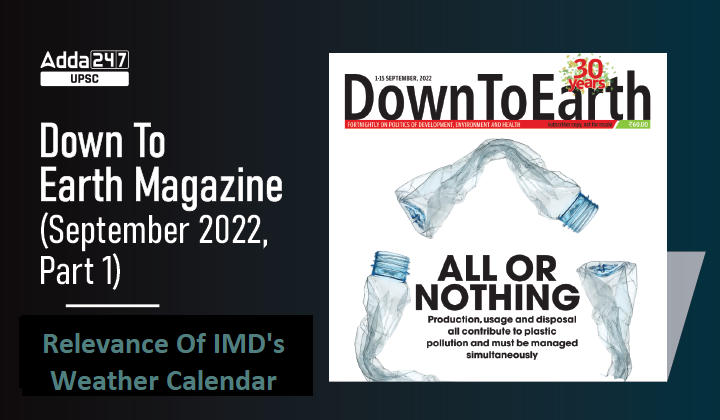Table of Contents
Down To Earth Magazine is a fortnightly magazine focusing on politics of environment and development, published in New Delhi, India.
UPSC Previous years’ questions on Development, Environment, Health and Disaster Management give us a clear idea about the increased importance of Down To Earth Magazine.
Down To Earth Magazine is one of the most important and indispensable sources for UPSC Civil Services Exam Preparation.
Keeping this in mind, here, we come with ”Gist Of Down To Earth Magazine” which covers important environmental current affairs articles in smooth pointed form, keeping in mind the demand of UPSC aspirants.
Relevance Of IMD’s Weather Calendar: Why in news?
India Meteorological Department’s data for 1988-2018, covering 676 of India’s 730 districts in 28 states and the Union Territory of Jammu and Kashmir, finds that over 60% of the districts have seen a decrease in the rain in June—the key month for sowing the Kharif crop.
Relevance Of IMD’s Weather Calendar: About IMD’s Weather Calendar
- In 1996, the India Meteorological Department (IMD) created the first-of-its-kind calendar with district-wise weather information for crop cultivation.
- It provided sowing and harvesting time, as well as weekly average rainfall and temperature during critical growth stages of the area’s major crops.
- Agriculture departments across the country used it to prescribe sowing dates to farmers.
- Over the years, the sowing schedule became India’s farming cycle, to the extent that at least two generations of farmers have now been following it.
Relevance Of IMD’s Weather Calendar: Should IMD Weather Calendar be revised?
- India still sows as per a calendar created on the weather of the 1990s, though rainfall and temperature patterns have seen a major shift in the date of arrival, frequency as well as distribution.
- As a result, farmers who adhere to the crop calendar often face crop loss.
- Overall, 55 per cent of India’s net sown area (139.42 million ha) is rain-dependent and grows 34 of the country’s 40-odd major crops, as per a July 2022 draft policy paper of the National Rainfed Area Authority (NRRA).
- This signifies the pressing need for a relook at the crop weather calendar, which NRRA also states in the paper:
“Long-term data for India indicates, that rainfed areas experience 3 to 4 drought years per decade. Of these, two to three are moderate and one or two are severe in intensity. Rain-fed crops are likely to be worst hit due to limited options of coping with variability of rainfall and temperature resulting in a shift in sowing time and shorter growing season, which may necessitate effective adjustment in sowing and harvesting dates. Increasing intra seasonal variability of rainfall has become a major concern.”
Relevance Of IMD’s Weather Calendar: What is the False Start Phenomena?
- It refers to a situation where the first spell of rain is followed by a dry spell lasting a week or more.
- There is not much difference in the onset of rain but the major concern is the break in rain once you have sown.
- A break in monsoon has been happening more in June. For rain-fed areas, there is no other option because the sowing window is only till July 10-15.
- False start condition is very vital, because it leads to germination failure and re-sowing by farmers resulting in increased cost of cultivation, states a paper published in Agricultural and Forest Meteorology journal on March 14, 2022
Relevance Of IMD’s Weather Calendar: What is Dry Spell Index (DSI) ?
- ICAR scientists have tried to see the length and impact of a dry spell and have defined a new index called the dry spell index (DSI) in a paper published in the journal Agricultural and Forest Meteorology in December 2021.
- The index can be used to recommend area-specific crops based on new rain patterns.
- The research finds that DSI is better in quantifying the reduction in yield due to a dry spell, as compared to the Standardised Precipitation Index (SPI), widely used by government agencies to monitor soil moisture levels.
- It takes into account the cumulative seasonal rainfall, not the length and impact of dry spells.
- The information on the continuance of dry spells in a season is vital in deciding a particular crop or crop variety, and to breed varieties of various crop durations for a specific location and deciding adaptation strategies, supplementary irrigation and field operations in agriculture.
Relevance Of IMD’s Weather Calendar: What immediate steps should be taken?
Granular Assessment
Climate change should be integrated into crop calendars at the hyper local level as we cannot have a straight cut fit for the whole of India because the monsoonal pattern is not the same or uniform across Indian districts.
Contingency Plans
- Ideally, district-wise contingency plans for agriculture should be put into action depending on the rainfall deficit. In 2010, ICAR-CRIDA prepared a contingency plan for all the districts.
- The plan includes information about the district’s agroecological zone; rainfall, irrigation and land use patterns; crops cultivated and the sowing window, among others. It also lists the kinds of emergencies the district is prone to and strategies to counter them.
Relevance Of IMD’s Weather Calendar: Conclusion
Adapting to the changed rain pattern, farmers already have started to delay sowing. Many farmers have skipped sowing in June due to high risks that come with uncertain rains. As the farmers understand that the timing is not optimal for the crops and voluntarily push the sowing to July. For better measurement, assessment and similarity of the NET shown area, the IMD and ICAR should prepare an updated weather calendar as soon as possible.



 TSPSC Group 1 Question Paper 2024, Downl...
TSPSC Group 1 Question Paper 2024, Downl...
 TSPSC Group 1 Answer key 2024 Out, Downl...
TSPSC Group 1 Answer key 2024 Out, Downl...
 UPSC Prelims 2024 Question Paper, Downlo...
UPSC Prelims 2024 Question Paper, Downlo...
